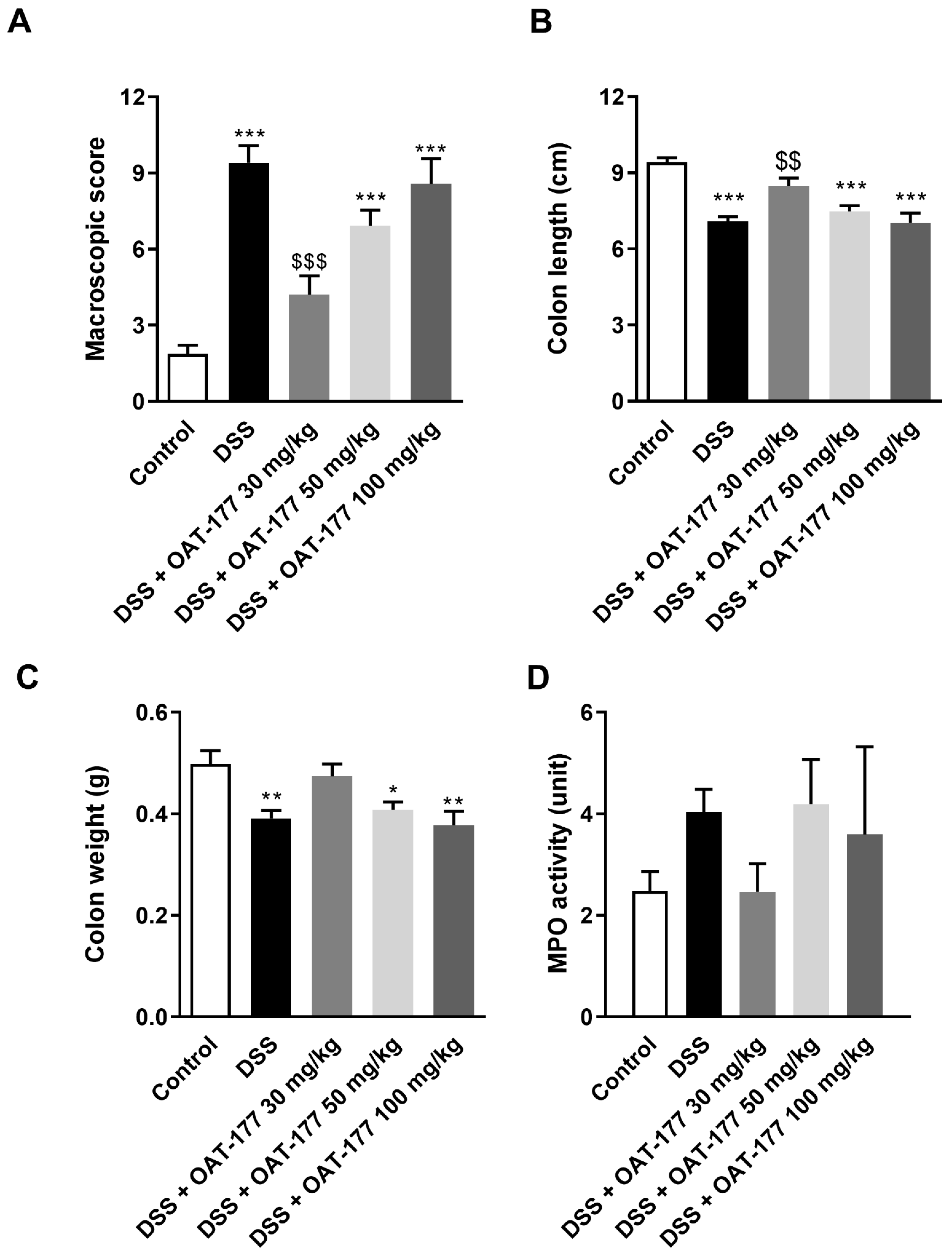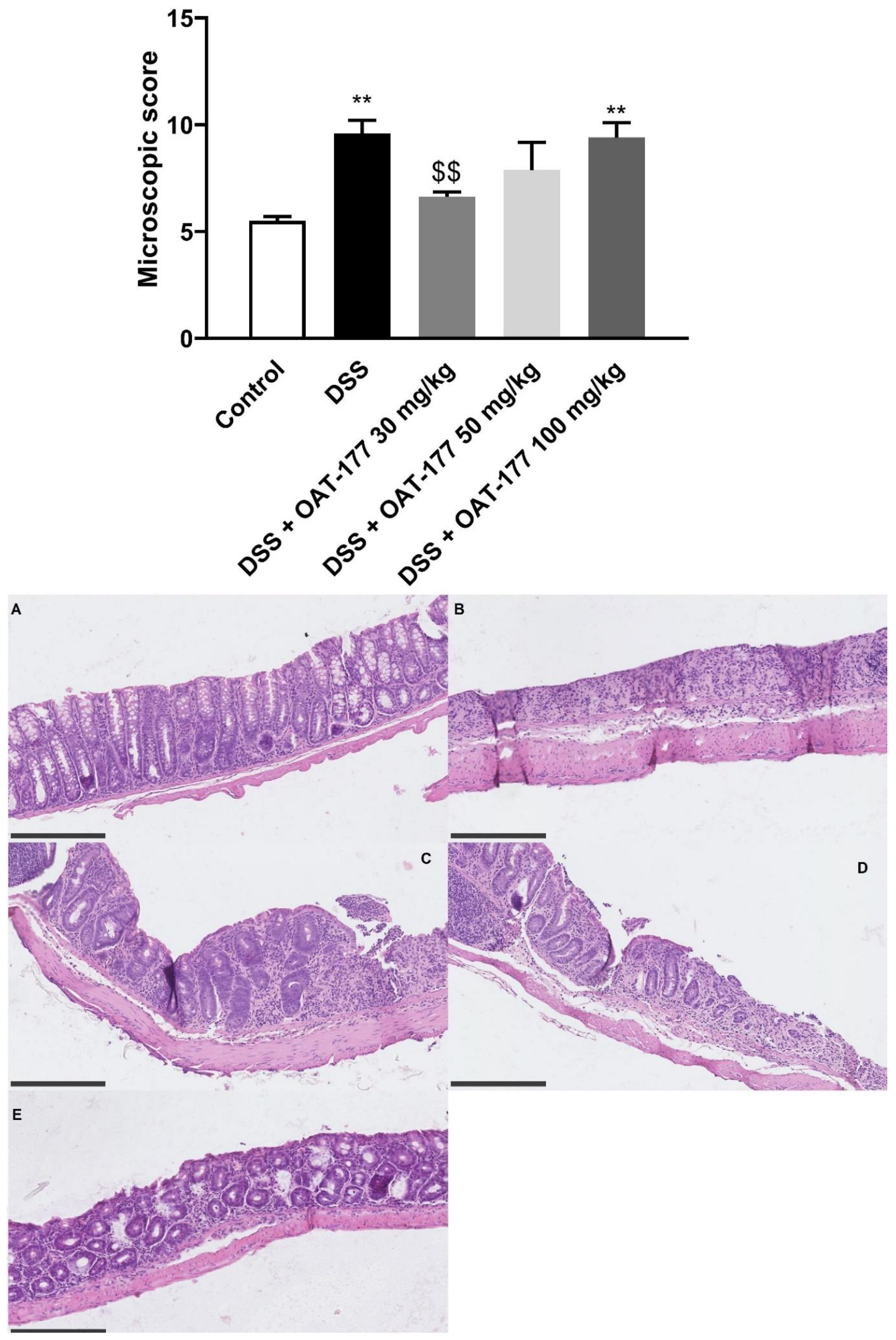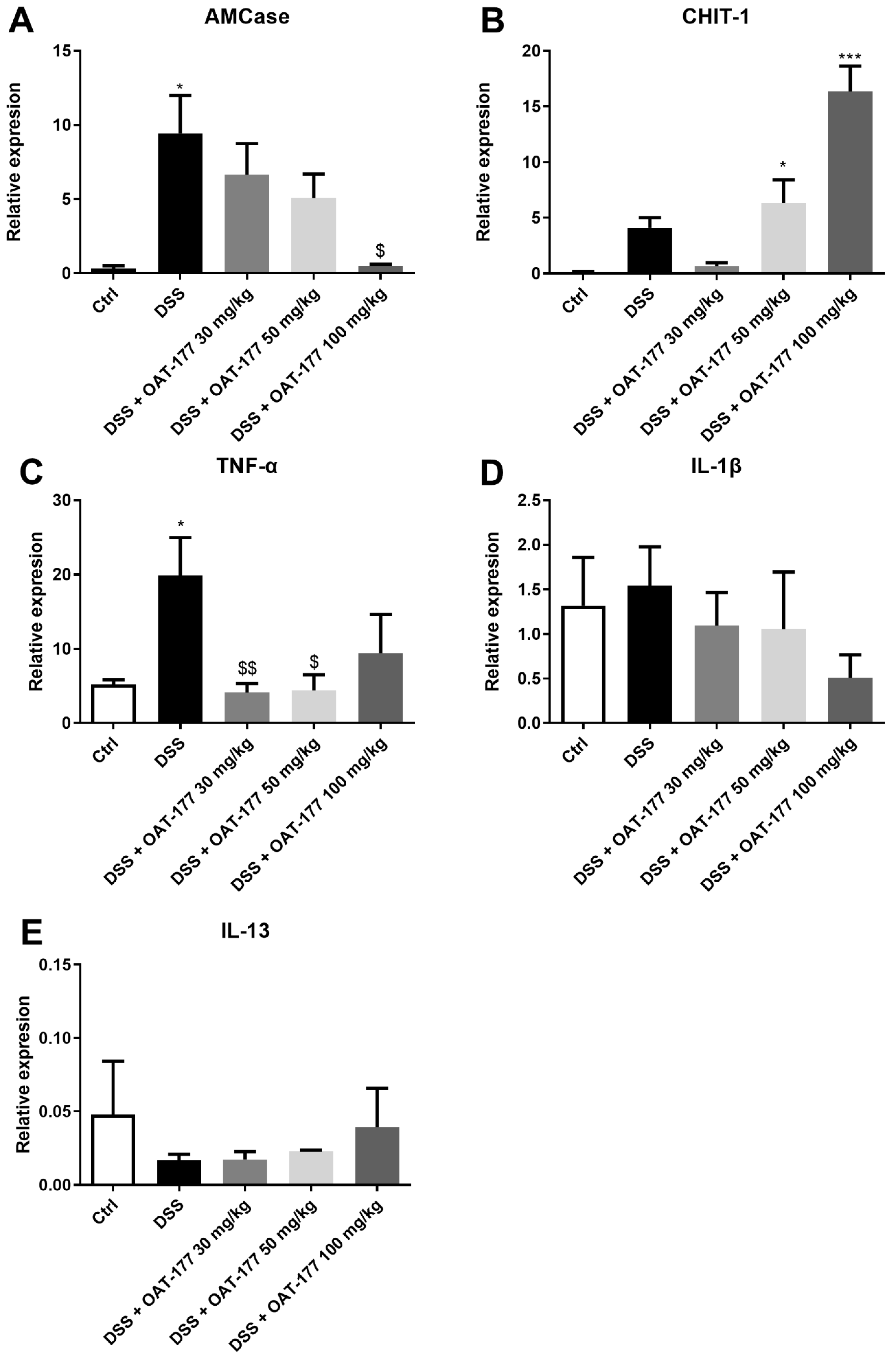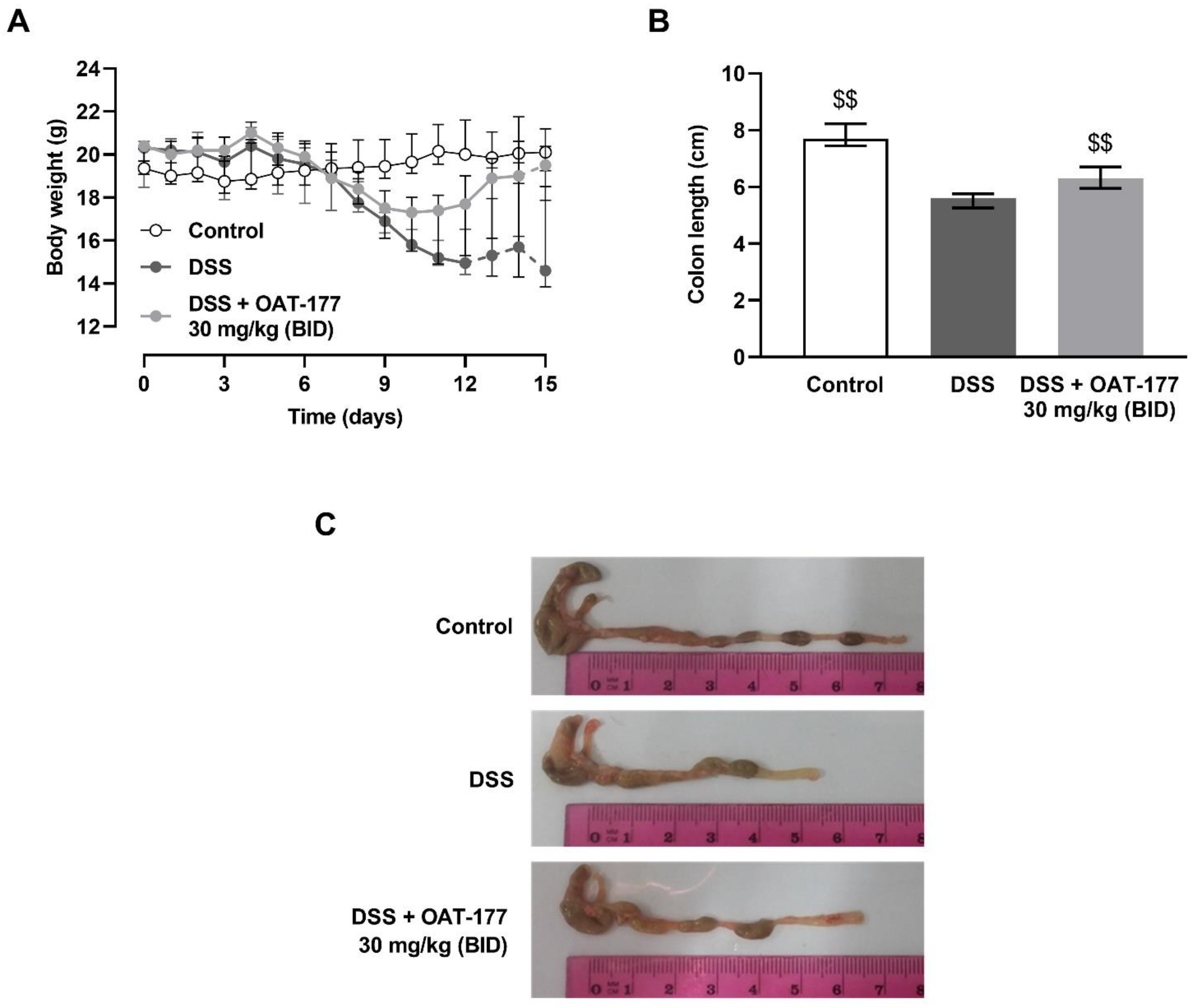The Anti-Inflammatory Effect of Acidic Mammalian Chitinase Inhibitor OAT-177 in DSS-Induced Mouse Model of Colitis
Abstract
:1. Introduction
2. Results
2.1. OAT-177 Administered Intragastrically in the Short-Term Therapeutic Protocol Attenuated Colitis in the DSS-Induced Mouse Model
2.2. OAT-177 Administered Intragastrically in the Short-Term Therapeutic-Protocol-Induced Changes in the Inflammatory Cytokine Profile
2.3. The Anti-Inflammatory Effect of OAT-177 Is Also Present after Intraperitoneal Administration in the Short-Term Therapeutic Protocol
2.4. OAT-177 Administered Intragastrically in the Long-Term Therapeutic-Protocol-Attenuated Colitis in the DSS-Induced Mouse Model
3. Discussion
4. Materials and Methods
4.1. Experimental Animals
4.2. Induction of Colitis
4.3. Pharmacological Treatment
4.4. Macroscopic Evaluation of Colonic Damage
4.5. Microscopic Inflammation Score Evaluation
4.6. Determination of Tissue Myeloperoxidase Activity
4.7. RNA Isolation
4.8. Reverse Transcription and Real-Time RT PCR
4.9. Statistical Analysis
Author Contributions
Funding
Institutional Review Board Statement
Informed Consent Statement
Data Availability Statement
Conflicts of Interest
References
- Binienda, A.; Fichna, J.; Salaga, M. Recent advances in inflammatory bowel disease therapy. Eur. J. Pharm. Sci. Off. J. Eur. Fed. Pharm. Sci. 2020, 155, 105550. [Google Scholar] [CrossRef] [PubMed]
- Sobczak, M.; Fabisiak, A.; Murawska, N.; Wesołowska, E.; Wierzbicka, P.; Wlazłowski, M.; Wójcikowska, M.; Zatorski, H.; Zwolińska, M.; Fichna, J. Current overview of extrinsic and intrinsic factors in etiology and progression of inflammatory bowel diseases. Pharmacol. Rep. 2014, 66, 766–775. [Google Scholar] [CrossRef] [PubMed]
- Hazel, K.; O’Connor, A. Emerging treatments for inflammatory bowel disease. Ther. Adv. Chronic Dis. 2020, 11, 2040622319899297. [Google Scholar] [CrossRef] [PubMed]
- Pithadia, A.B.; Jain, S. Treatment of inflammatory bowel disease (IBD). Pharmacol. Rep. 2011, 63, 629–642. [Google Scholar] [CrossRef]
- Sandborn, W.J.; Ferrante, M.; Bhandari, B.R.; Berliba, E.; Feagan, B.G.; Hibi, T.; Tuttle, J.L.; Klekotka, P.; Friedrich, S.; Durante, M.; et al. Efficacy and Safety of Mirikizumab in a Randomized Phase 2 Study of Patients With Ulcerative Colitis. Gastroenterology 2020, 158, 537–549.e10. [Google Scholar] [CrossRef] [Green Version]
- Sands, B.E.; Sandborn, W.J.; Panaccione, R.; O’Brien, C.D.; Zhang, H.; Johanns, J.; Adedokun, O.J.; Li, K.; Peyrin-Biroulet, L.; Van Assche, G.; et al. Ustekinumab as Induction and Maintenance Therapy for Ulcerative Colitis. N. Engl. J. Med. 2019, 381, 1201–1214. [Google Scholar] [CrossRef] [PubMed]
- Pai, N.; Popov, J.; Hill, L.; Hartung, E. Protocol for a double-blind, randomised, placebo-controlled pilot study for assessing the feasibility and efficacy of faecal microbiota transplant in a paediatric Crohn’s disease population: PediCRaFT Trial. BMJ Open 2019, 9, e030120. [Google Scholar] [CrossRef]
- Mishra, R.; Dhawan, P.; Srivastava, A.S.; Singh, A.B. Inflammatory bowel disease: Therapeutic limitations and prospective of the stem cell therapy. World J. Stem Cells 2020, 12, 1050–1066. [Google Scholar] [CrossRef]
- Mazur, M.; Zielińska, A.; Grzybowski, M.M.; Olczak, J.; Fichna, J. Chitinases and Chitinase-Like Proteins as Therapeutic Targets in Inflammatory Diseases, with a Special Focus on Inflammatory Bowel Diseases. Int. J. Mol. Sci. 2021, 22, 6966. [Google Scholar] [CrossRef]
- Kanneganti, M.; Kamba, A.; Mizoguchi, E. Role of chitotriosidase (Chitinase 1) under normal and disease conditions. J. Epithel. Biol. Pharmacol. 2012, 5, 1–9. [Google Scholar] [CrossRef]
- Cozzarini, E.; Bellin, M.; Norberto, L.; Polese, L.; Musumeci, S.; Lanfranchi, G.; Paoletti, M.G. CHIT1 and AMCase expression in human gastric mucosa: Correlation with inflammation and Helicobacter pylori infection. Eur. J. Gastroenterol. Hepatol. 2009, 21, 1119–1126. [Google Scholar] [CrossRef]
- Kim, L.K.; Morita, R.; Kobayashi, Y.; Eisenbarth, S.C.; Lee, C.G.; Elias, J.; Eynon, E.E.; Flavell, R.A. AMCase is a crucial regulator of type 2 immune responses to inhaled house dust mites. Proc. Natl. Acad. Sci. USA 2015, 112, E2891–E2899. [Google Scholar] [CrossRef] [Green Version]
- Zhu, Z.; Zheng, T.; Homer, R.J.; Kim, Y.K.; Chen, N.Y.; Cohn, L.; Hamid, Q.; Elias, J.A. Acidic mammalian chitinase in asthmatic Th2 inflammation and IL-13 pathway activation. Science 2004, 304, 1678–1682. [Google Scholar] [CrossRef]
- Rao, F.V.; Andersen, O.A.; Vora, K.A.; Demartino, J.A.; van Aalten, D.M.F. Methylxanthine drugs are chitinase inhibitors: Investigation of inhibition and binding modes. Chem. Biol. 2005, 12, 973–980. [Google Scholar] [CrossRef] [Green Version]
- Mazur, M.; Olczak, J.; Olejniczak, S.; Koralewski, R.; Czestkowski, W.; Jedrzejczak, A.; Golab, J.; Dzwonek, K.; Dymek, B.; Sklepkiewicz, P.L.; et al. Targeting Acidic Mammalian chitinase Is Effective in Animal Model of Asthma. J. Med. Chem. 2018, 61, 695–710. [Google Scholar] [CrossRef]
- Krzeminski, L.; Czestkowski, W.; Mazur, M.; Bartoszewicz, A.; Olejniczak, S.; Siwinska, A.; Krysztofiak, K.; Belczyk-Ciesielska, A.; Koziel, R.; Papiernik, D.; et al. Discovery of small molecule compounds interfering with YKL-40 carbohydrate binding as potential therapeutics for cancer. In Proceedings of the Abstracts of Papers of the American Chemical Society, San Diego, CA, USA, 25–29 August 2019; Volume 258. [Google Scholar]
- Zielinska, M.; Szymaszkiewicz, A.; Salaga, M.; Zatorski, H.; Wlodarczyk, J.; Jacenik, D.; Kordek, R.; Krajewska, W.M.; Misicka, A.; Fichna, J.; et al. High activity of the endogenous opioid system and acute but not chronic stress influence experimental colitis development in mice. J. Physiol. Pharmacol. An Off. J. Polish Physiol. Soc. 2018, 69, 769–778. [Google Scholar] [CrossRef]
- Krajewska, J.B.; Włodarczyk, J.; Jacenik, D.; Kordek, R.; Taciak, P.; Szczepaniak, R.; Fichna, J. New Class of Anti-Inflammatory Therapeutics Based on Gold (III) Complexes in Intestinal Inflammation-Proof of Concept Based on In Vitro and In Vivo Studies. Int. J. Mol. Sci. 2021, 22, 3121. [Google Scholar] [CrossRef]
- Grosso, S.; Margollicci, M.A.; Bargagli, E.; Buccoliero, R.; Perrone, A.; Galimberti, D.; Morgese, G.; Balestri, P.; Rottoli, P. Serum levels of chitotriosidase as a marker of disease activity and clinical stage in sarcoidosis. Scand. J. Clin. Lab. Invest. 2004, 64, 57–62. [Google Scholar] [CrossRef]
- Létuvé, S.; Kozhich, A.; Humbles, A.; Brewah, Y.; Dombret, M.-C.; Grandsaigne, M.; Adle, H.; Kolbeck, R.; Aubier, M.; Coyle, A.J.; et al. Lung chitinolytic activity and chitotriosidase are elevated in chronic obstructive pulmonary disease and contribute to lung inflammation. Am. J. Pathol. 2010, 176, 638–649. [Google Scholar] [CrossRef] [Green Version]
- Lee, C.G.; Herzog, E.L.; Ahangari, F.; Zhou, Y.; Gulati, M.; Lee, C.-M.; Peng, X.; Feghali-Bostwick, C.; Jimenez, S.A.; Varga, J.; et al. Chitinase 1 Is a Biomarker for and Therapeutic Target in Scleroderma-Associated Interstitial Lung Disease That Augments TGF-β1 Signaling. J. Immunol. 2012, 189, 2635–2644. [Google Scholar] [CrossRef] [Green Version]
- Mizoguchi, E. Chitinase 3-like-1 exacerbates intestinal inflammation by enhancing bacterial adhesion and invasion in colonic epithelial cells. Gastroenterology 2006, 130, 398–411. [Google Scholar] [CrossRef] [PubMed]
- Low, D.; Tran, H.T.; Lee, I.-A.; Dreux, N.; Kamba, A.; Reinecker, H.-C.; Darfeuille-Michaud, A.; Barnich, N.; Mizoguchi, E. Chitin-binding domains of Escherichia coli ChiA mediate interactions with intestinal epithelial cells in mice with colitis. Gastroenterology 2013, 145, 602–612.e9. [Google Scholar] [CrossRef] [Green Version]
- Di Rosa, M.; Distefano, G.; Zorena, K.; Malaguarnera, L. Chitinases and immunity: Ancestral molecules with new functions. Immunobiology 2015, 221, 399–411. [Google Scholar] [CrossRef] [PubMed]
- Ziatabar, S.; Zepf, J.; Rich, S.; Danielson, B.T.; Bollyky, P.I.; Stern, R. Chitin, chitinases, and chitin lectins: Emerging roles in human pathophysiology. Pathophysiology 2018, 25, 253–262. [Google Scholar] [CrossRef] [PubMed]
- Kawada, M.; Chen, C.-C.; Arihiro, A.; Nagatani, K.; Watanabe, T.; Mizoguchi, E. Chitinase 3-like-1 enhances bacterial adhesion to colonic epithelial cells through the interaction with bacterial chitin-binding protein. Lab. Investig. 2008, 88, 883–895. [Google Scholar] [CrossRef] [PubMed] [Green Version]
- Ohno, M.; Togashi, Y.; Tsuda, K.; Okawa, K.; Kamaya, M.; Sakaguchi, M.; Sugahara, Y.; Oyama, F. Quantification of Chitinase mRNA Levels in Human and Mouse Tissues by Real-Time PCR: Species-Specific Expression of Acidic Mammalian Chitinase in Stomach Tissues. PLoS ONE 2013, 8, e67399. [Google Scholar] [CrossRef] [PubMed]
- Dymek, B.; Sklepkiewicz, P.; Mlacki, M.; Zagozdzon, A.; Koralewski, R.; Mazur, M.; Paplinska-Goryca, M.; Nejman-Gryz, P.; Proboszcz, M.; Gorska, K.; et al. CHIT1 is a novel therapeutic target in idiopathic pulmonary fibrosis (IPF): Anti-fibrotic efficacy of OATD-01, a potent and selective chitinase inhibitor in the mouse model of pulmonary fibrosis. Eur. Respir. J. 2018, 52, OA5361. [Google Scholar] [CrossRef]
- Yang, C.J.; Liu, Y.K.; Liu, C.L.; Shen, C.N.; Kuo, M.L.; Su, C.C.; Tseng, C.P.; Yen, T.C.; Shen, C.R. Inhibition of acidic mammalian chitinase by RNA interference suppresses ovalbumin-sensitized allergic asthma. Hum. Gene Ther. 2009, 20, 1597–1606. [Google Scholar] [CrossRef]
- Sutherland, T.E.; Andersen, O.A.; Betou, M.; Eggleston, I.M.; Maizels, R.M.; van Aalten, D.; Allen, J.E. Analyzing airway inflammation with chemical biology: Dissection of acidic mammalian chitinase function with a selective drug-like inhibitor. Chem. Biol. 2011, 18, 569–579. [Google Scholar] [CrossRef] [Green Version]
- Cole, D.C.; Olland, A.M.; Jacob, J.; Brooks, J.; Bursavich, M.G.; Czerwinski, R.; DeClercq, C.; Johnson, M.; Joseph-McCarthy, D.; Ellingboe, J.W.; et al. Identification and characterization of acidic mammalian chitinase inhibitors. J. Med. Chem. 2010, 53, 6122–6128. [Google Scholar] [CrossRef]
- Andryianau, G.; Kowalski, M.; Piotrowicz, M.C.; Rajkiewicz, A.A.; Dymek, B.; Sklepkiewicz, P.L.; Pluta, E.; Stefaniak, F.; Czestkowski, W.; Olejniczak, S.; et al. Benzoxazepine-Derived Selective, Orally Bioavailable Inhibitor of Human Acidic Mammalian Chitinase. ACS Med. Chem. Lett. 2020, 11, 1228–1235. [Google Scholar] [CrossRef]
- Mazur, M.; Dymek, B.; Koralewski, R.; Sklepkiewicz, P.; Olejniczak, S.; Mazurkiewicz, M.; Piotrowicz, M.; Salamon, M.; Jędrzejczak, K.; Zagozdzon, A.; et al. Development of Dual Chitinase Inhibitors as Potential New Treatment for Respiratory System Diseases. J. Med. Chem. 2019, 62, 7126–7145. [Google Scholar] [CrossRef]
- Lee, I.-A.; Low, D.; Kamba, A.; Llado, V.; Mizoguchi, E. Oral caffeine administration ameliorates acute colitis by suppressing chitinase 3-like 1 expression in intestinal epithelial cells. J. Gastroenterol. 2014, 49, 1206–1216. [Google Scholar] [CrossRef] [Green Version]
- Lee, I.A.; Kamba, A.; Low, D.; Mizoguchi, E. Novel methylxanthine derivative-mediated anti-inflammatory effects in inflammatory bowel disease. World J. Gastroenterol. 2014, 20, 1127–1138. [Google Scholar] [CrossRef]
- Peterson, T.C.; Peterson, M.R.; Raoul, J.M. The effect of pentoxifylline and its metabolite-1 on inflammation and fibrosis in the TNBS model of colitis. Eur. J. Pharmacol. 2011, 662, 47–54. [Google Scholar] [CrossRef]
- Murthy, S.; Cooper, H.S.; Yoshitake, H.; Meyer, C.; Meyer, C.J.; Murthy, N.S. Combination therapy of pentoxifylline and TNFalpha monoclonal antibody in dextran sulphate-induced mouse colitis. Aliment. Pharmacol. Ther. 1999, 13, 251–260. [Google Scholar] [CrossRef]





Publisher’s Note: MDPI stays neutral with regard to jurisdictional claims in published maps and institutional affiliations. |
© 2022 by the authors. Licensee MDPI, Basel, Switzerland. This article is an open access article distributed under the terms and conditions of the Creative Commons Attribution (CC BY) license (https://creativecommons.org/licenses/by/4.0/).
Share and Cite
Mazur, M.; Włodarczyk, J.; Świerczyński, M.; Kordek, R.; Grzybowski, M.M.; Olczak, J.; Fichna, J. The Anti-Inflammatory Effect of Acidic Mammalian Chitinase Inhibitor OAT-177 in DSS-Induced Mouse Model of Colitis. Int. J. Mol. Sci. 2022, 23, 2159. https://doi.org/10.3390/ijms23042159
Mazur M, Włodarczyk J, Świerczyński M, Kordek R, Grzybowski MM, Olczak J, Fichna J. The Anti-Inflammatory Effect of Acidic Mammalian Chitinase Inhibitor OAT-177 in DSS-Induced Mouse Model of Colitis. International Journal of Molecular Sciences. 2022; 23(4):2159. https://doi.org/10.3390/ijms23042159
Chicago/Turabian StyleMazur, Marzena, Jakub Włodarczyk, Mikołaj Świerczyński, Radzisław Kordek, Marcin M. Grzybowski, Jacek Olczak, and Jakub Fichna. 2022. "The Anti-Inflammatory Effect of Acidic Mammalian Chitinase Inhibitor OAT-177 in DSS-Induced Mouse Model of Colitis" International Journal of Molecular Sciences 23, no. 4: 2159. https://doi.org/10.3390/ijms23042159





